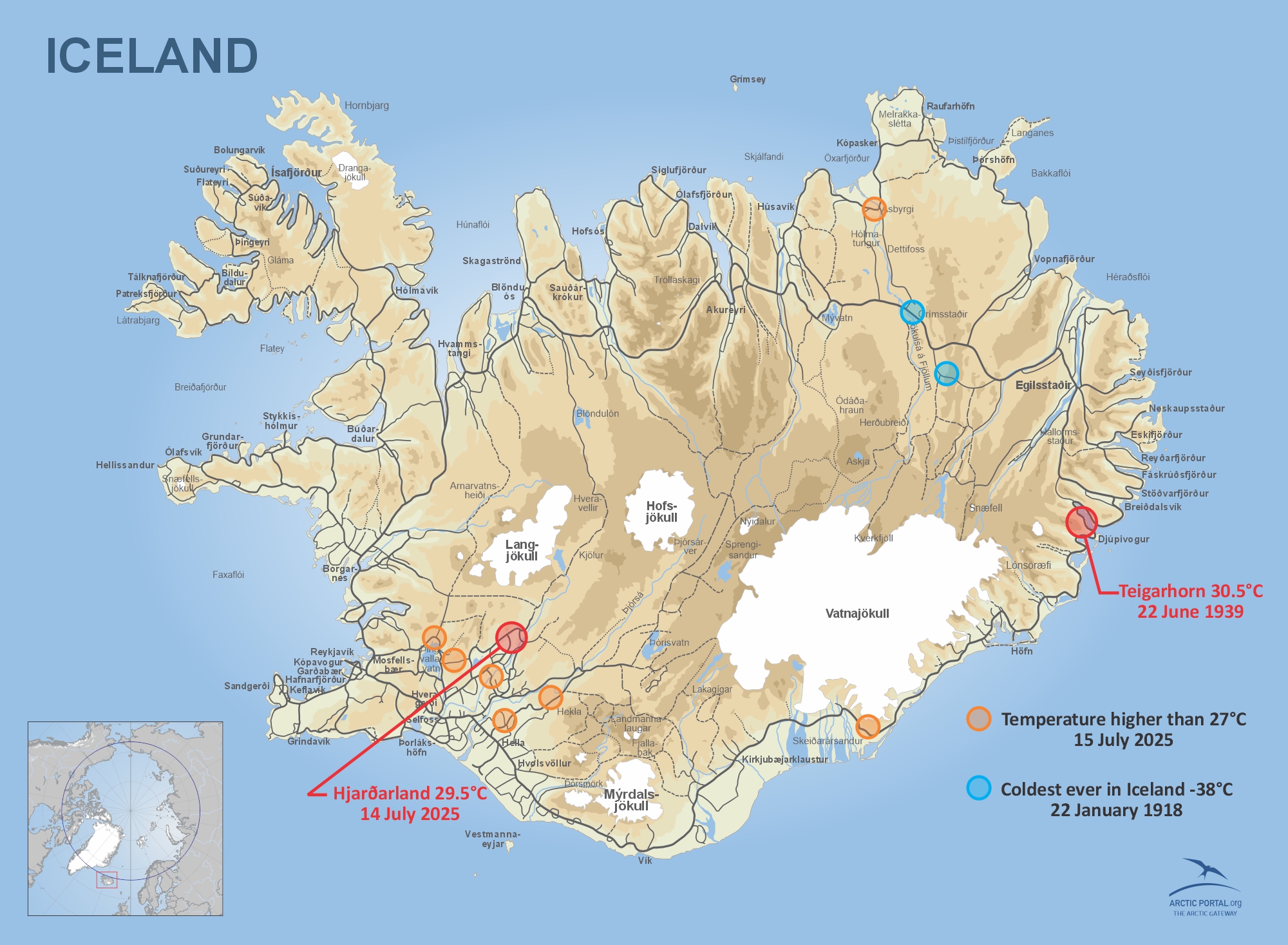July 2025 has delivered the warmest day of the summer so far in Iceland, with numerous weather stations across the country reporting record-breaking temperatures. In several locations, the new records surpassed previous ones by an astonishing margin, in some cases, over 8°C, a rare and striking leap in meteorological history.
According to the Icelandic Meteorological Office (IMO), the highest temperature of 14 July was recorded in Hjarðarból in Biskupstungur, where the mercury soared to 29.5°C, a new local record. This is just one degree shy of Iceland’s all-time national heat record of 30.5°C, set in Teigarhorn in Berufjörður on June 22, 1939 (see location on the map).
“Such jumps in temperature records are highly unusual and demonstrate just how warm it was today,” said Kristín Hermannsdóttir, Head of Weather Services at the IMO (mbl.is).
Unprecedented Warmth Across the Country
Sunshine bathed nearly all regions of Iceland on the 14th & 15th of July, with temperatures climbing well above 25°C in many areas. Several stations, including Þingvellir, Skálholt, Kálfhóll, and Bræðratunguvegur, reported temperatures exceeding 28°C, an extraordinary reading for the sub-Arctic island, even in midsummer.
Reykjavík experienced a high of 20.8°C, the first time temperatures in the capital exceeded 20°C this year and the first such day since August 2023.
New daily high-temperature records were set at numerous other stations, including:
- Þingvellir, Mörk á Landi, Öræfi, and Ásbyrgi, each reaching or surpassing 27°C
- In some places, today’s temperatures exceeded previous daily records by more than 8°C, a jump rarely seen in Iceland's climate data
These July extremes come on the heels of an exceptionally warm May 2025, which was the warmest May on record in most parts of the country. According to the IMO:
- The average temperature in Reykjavík was 9.0°C, which is 2.3°C above the 1991–2020 average.
- Akureyri recorded an average temperature of 10.1°C, an astonishing 3.9°C above the long-term average and 3.5°C above the 10-year average.
- May set all-time temperature records in multiple locations with more than a century of continuous measurement, including Akureyri (145 years), Grímsey (152 years), Grímsstaðir á Fjöllum (119 years), Reykjavík (155 years), Stykkishólmur (180 years), and Teigarhorn (153 years).
- In Grímsey, May was 1.4°C warmer than the previous record from 1939, while Egilsstaðir saw temperatures 1.6°C above its previous record from 1991.
Nationwide, the average May temperature across inhabited areas was 8.4°C, surpassing the former national May record of 7.6°C set in 1935.
What’s Causing the Heat?
The IMO attributes the hot spell to a rare combination of large-scale weather systems: a stationary low-pressure system near the British Isles and a high-pressure area northeast of Iceland. Together, these systems are funneling unusually warm air masses toward the country.
The conditions have also brought calm winds, sea breezes, and clear skies, which further amplify the heat.
Iceland’s Extreme Temperature Records
- Highest ever recorded in Iceland: 30.5°C (Teigarhorn, June 22, 1939 - see location on map)
- Coldest ever in Iceland: -38°C (Grímsstaðir and Möðrudalur, January 22, 1918 - see location on map)
- Reykjavík’s hottest day: 24.3°C (July 9, 1976)
- Reykjavík’s coldest day: -24.5°C (January 21, 1918)
Globally, the extremes are even more dramatic:
- World’s hottest recorded temperature: 57.7°C (Libya)
- World’s coldest recorded temperature: -89.2°C (Antarctica)
Norway Also Faces Unusual Heat
This Nordic heatwave isn't limited to Iceland. In Norway, temperatures are pushing to record-breaking levels as well. Meteorologists predict the country’s all-time high of 35.6°C, set in Nesbyen, Buskerud in 1970, may fall today.
As of early afternoon, five of the hottest locations in Norway were all in Trøndelag, where readings ranged from 32.6°C to 33.6°C. The hottest day of 2025 in Norway so far was just a few days ago, with 33.8°C measured in Sauda, Rogaland.
Meteorologist Charalampos Sarchosidis from the Norwegian Meteorological Institute told NRK that Northern Trøndelag, near the Nordland county border, is the most likely place to surpass the long-standing record.
Sources:Veðurstofa Íslands, mbl.is, Vísindavefurinn, VG.no
Map: Arctic Portal

